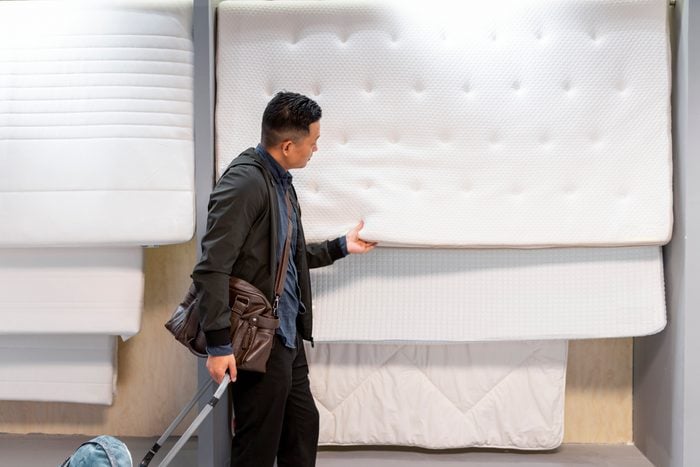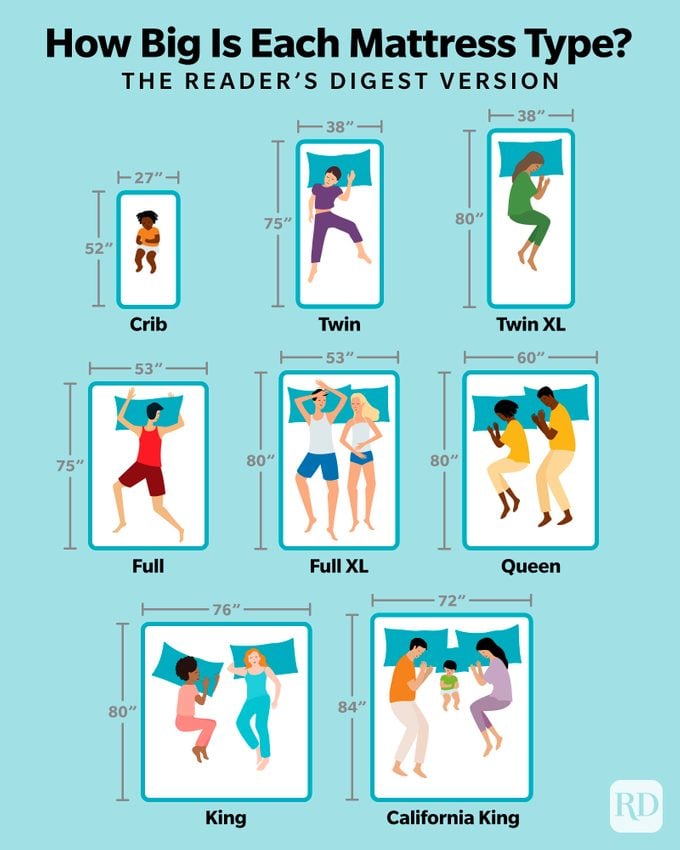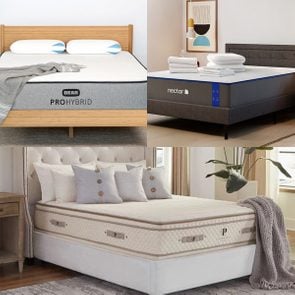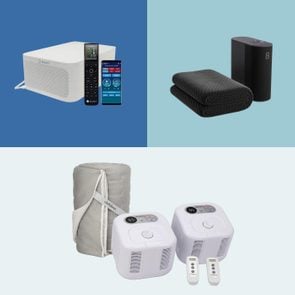This Handy Cheat Sheet for Mattress Sizes Will Help You Choose the Best Bed for You and Your Space
Updated: Aug. 22, 2023

We've included even the most obscure mattress sizes, as well as answering your most pressing questions about which mattress you want
Part of deciding how to buy a mattress that meets your needs is thinking critically about cost, number of sleepers and room size. Each of those has an impact on the best mattress sizes for you, and comfort is the very important last piece of the puzzle. From the twin mattress to the queen mattress to the king-size mattress (and many others you’ve probably never even heard of), we’re breaking down all your options to help you narrow down the best mattresses on the market for your perfect fit.
What mattress sizes can you buy?

There are far more mattress sizes than you’d expect. The most common ones you can find readily available include mini crib, crib, twin, full, queen, king and California king. If you want a bed in a box or one of the best mattresses on Amazon, or perhaps the best memory foam mattress or best air mattress, these standard sizes should be considered first. Others, like the twin XL, can be a little trickier to find, and in some cases like the 3/4 or family size, they have to be custom ordered. Keep reading for a full breakdown of mattress sizes, or check out our mattress size chart for easy reference.
Mini Crib
Dimensions: 38 by 24 inches
Best for: Babies and small rooms
The mini crib size is a relatively new phenomenon. It’s loved because it’s more than a foot shorter than the standard crib mattress, which is ideal if you’re short on space. You can have multiples in one bedroom, the bedroom can double as the playroom and it’s a good solution if the bedroom is simply small. Another bonus: It runs around $70–$100 cheaper than the standard size.
Crib
Dimensions: 52 by 28 inches
Best for: Babies and toddlers
While the mini crib is picking up traction, there are still standard options available that make this size of crib mattress appealing. You’ll technically spend a little more, but the extra length means your toddler won’t outgrow it as quickly, which can also save your sanity—which is priceless.
Twin
Dimensions: 75 by 38 inches
Best for: Bunk beds, daybeds, kids and small rooms
Most bunk beds and daybeds, both loved for how they creatively utilize space in a room, are designed to fit twin-size mattresses. As the most petite standard size an adult can fit on, it’s a great option for smaller rooms regardless of what kind of bed accompanies it. It’s also common for kids to graduate into a twin after they’re out of their crib because it’s big enough to provide them more space and small enough to prevent them from thrashing around all night long.
Twin XL
Dimensions: 80 by 38 inches
Best for: Dorms, split king beds and taller people with small rooms
Who among us doesn’t remember the twin XL in our dorm room? Twin XL is considered the university standard because it’s basically the twin mattress size, but with an extra 5 inches of length. It’s at once space-saving and accommodating. This is also what makes it ideal for taller people with small rooms. Two twin XL mattresses make up a split king bed, which, as the name implies, is a king-size bed split down the middle so two people with different mattress needs can comfortably sleep in the same bed.
Full
Dimensions: 75 by 53 inches
Best for: Solo sleepers with pets or a kid and small rooms
The first step up from a twin/single bed, you can technically fit two adults on a full bed, but it’s better for solo sleepers in small rooms. And if they have pets or a kid they often sleep with? The more (within reason), the merrier.
Queen
Dimensions: 80 by 60 inches
Best for: Standard rooms and average-size partners or single adults with a pet
Of all the mattress sizes, this one is the most common by far. This is because it fits well in standard rooms and can easily accommodate average-size partners or single adults with a pet. No matter what you’re looking for, whether it be the best mattress for back pain, best mattress for side sleepers or best cooling mattress, you’ll find it in the queen size.
King
Dimensions: 80 by 76 inches
Best for: Partners with pets
There’s a reason people look forward to upgrading from a queen to a king, and it’s the impressive 16 extra inches you gain in width to spread out (especially helpful with snuggly pets). And if you’re a solo sleeper who loves to sprawl out and roll around, who says you can’t have a huge mattress?
California King
Dimensions: 84 by 72 inches
Best for: Taller partners with pets
The California king provides an extra 4 inches of length than the standard king size, though you do lose 4 inches in width. For those with a little extra height or pets that insist on snoozing at the foot of the bed, the added length will make such a big difference, they won’t even notice the width.
Less common mattress sizes
If you’re in the market for something highly specialized, there are other options. Just keep in mind that it may be more difficult to find the best sheets and other bedding that fits like a glove.
3/4
Dimensions: 75 by 48 inches
Best for: Antique beds
At first glance, you may not notice that the antique bed you snagged from that estate sale is a unique size, but it is—and it’s most likely 75 by 48 inches (aka 3/4 size). Because this mattress is so difficult to find ready-made, it’s typically one you only get when you’re trying to fit a certain bed.
Small Single
Dimensions: 75 by 30 inches
Best for: Kids and extra-small rooms
The small single is the same length as a standard twin, but 8 inches more narrow. It may not be the most comfortable for adults but can definitely get the job done in an extra-small room. Kids can also fit with plenty of room to spare.
Super Single
Dimensions: 84 by 48 inches
Best for: Solo sleepers who need extra space and small rooms
While the small single was like a narrow twin (8 inches less width), the super single is more like a narrow and long full (5 inches less width and 9 inches more length). If a twin just won’t cut it for you but a full is too big for the space you’re working with, try the super single.
Full XL
Dimensions: 80 by 53 inches
Best for: Taller people with a small room and a pet
The difference between the full XL and full-size mattress is 5 inches of length. If you’re on the tall side and want more sleeping space than a twin can provide (whether just for you or you and a furry friend) but can’t quite fit a queen in your room, this is for you.
RV Queen
Dimensions: 75 by 60 inches
Best for: RVs and shorter rooms
When someone with a motorhome or travel trailer says they have a queen-size mattress installed, they actually have an RV queen, which is 5 inches shorter than the standard one. This is because RVs are designed as compact living spaces, so an actual queen can’t fit. Those with rooms that are short on length but not width can take advantage of the RV queen size too.
Olympic Queen
Dimensions: 80 by 66 inches
Best for: Average-size partners in average rooms who want to spread out a little
There’s a 16-inch difference in width between queen and king-size mattresses (60 inches versus 76 inches), and the olympic queen is the closest thing to middle ground. If you and your partner want a bit more wiggle room but can’t fit a king, you should get this one.
RV King
Dimensions: 80 by 72 inches
Best for: RVs and narrower rooms
Motorhomes and travel trailers, the gold standard of compact living, use the RV king because it’s 4 inches narrower than the regular king. You can also use it if you want the length of a king but don’t have room for the full width.
Wyoming King
Dimensions: 84 by 84 inches
Best for: Taller partners with pets and wide rooms
The most popular oversize mattress is the Wyoming king, likely because it’s the smallest. Compared with a king, it’s 4 inches longer and 8 inches wider. Just like with a California king, those who are taller and/or have pets will appreciate that extra length. The real difference, however, is the 84-inch width. If you’re struggling with an extra-wide room, those extra 8 inches will be a game changer proportionally.
Texas King
Dimensions: 98 by 80 inches
Best for: Much taller partners with pets and long rooms
For some, the extra 4 inches you gain in a California or Wyoming king versus a standard king are a game changer. Others may need even more legroom, which is where the Texas king comes in. It’s 18 inches longer than a standard king, allowing plenty of room for you—and your cats and dogs—to stretch out.
Alberta King
Dimensions: 96 by 96 inches
Best for: Especially tall partners with multiple pets or kids and large rooms
A mattress that’s 8 feet long and 8 feet wide can fit some pretty tall sleepers and then some. Multiple kids or pets can join in comfortably.
Alaskan King
Dimensions: 108 by 108 inches
Best for: Especially tall partners with multiple pets and/or kids and large rooms
The Alaskan king is often considered the biggest mattress—and from a length perspective, it definitely is. As a 9-foot square, it also has an impressive width that’s the appropriate scale for a large room. Especially tall partners who usually sleep with multiple pets and/or kids will appreciate all the elbow and legroom this one allows for.
Family
Dimensions: 80 by 120 inches
Best for: Three-plus adults, partners with a couple pets and/or kids, and extra-large rooms
At 10 feet wide, this mattress really can fit a family. We estimate at least three adults, or you and a partner plus one or two pets and/or kids. Note, this size is the same length as a standard queen or king mattress, but it can really fill out an extra-large room.
Family XL
Dimensions: 84 by 144 inches
Best for: Three-plus adults, partners with a lot of pets and/or kids, and extra-large rooms
Can you imagine a bed that’s 12 feet wide? That’s the family XL. You can fit a lot on this mattress along with you and a partner, including a host of pets and/or kids and at least one extra adult. If you have a room that’s closer to the size of a small house, it’ll fit right in.
How to find the right mattress size for you
Room size and layout
Most of the time, it’s obvious whether certain mattress sizes will physically fit into a room. Instead of worrying about a mattress that’s too big, you may need to worry about the opposite: a mattress that’s too small. Some rooms are so large that even a queen or king mattress will look miniscule. If that’s the case, you need to look more at scale to decide which size to get. In addition to size, layout also comes into play. You may find that with doors and funky angles, your bed can only work in one spot. Alternatively, you may have your choice of spots, but your mattress size depends on which you pick.
Number of sleepers
Logic follows that more sleepers require more space. When it comes to the most standard sizes like twin and queen, the number of sleepers a mattress can fit is intuitive. It’s when you get into more specialty sizes like the rare 3/4 or the oversize Texas king that things can get confusing if you’re trying to fit more than two adults. As a starting point, multiply the number of sleepers by the amount of space each person should have.
Size of sleepers
The phrase “it’s all relative” applies well to mattress sizes and the size of sleepers. For example, a full-size bed might be plenty wide for you, but at less than 4.5 feet long, it’s going to be too short for a lot of people. This is why it’s important to pay close attention to the measurements.
Sleeping style
Some people sleep very still, meaning they don’t need much dedicated room to move around and thus don’t technically need a larger mattress. Others would simply fall off the bed if they didn’t have the room to toss and turn.
Height
While length and width are important measurements, so is height. This is due to two things, the first being nightstand height. Nightstands average between 24 and 28 inches. You don’t want the mattress to end up lower than the nightstand, and you don’t want it more than a few inches higher either. Try to have your mattress fall in this range, including your frame and/or box spring.
The other consideration is your cooling mattress pad and sheet pocket depth. Every bedding manufacturer will tell you what this is, and you’ll just want to subtract 2 inches from them to get your maximum mattress height—any higher and your sheets may not stay tucked under. (By the way, we recommend Quince sheets and Sleep Number sheets.) If you’re currently on the hunt for one of the best mattress toppers, make sure your final pick is part of the maximum mattress height.
Price
Generally, the larger the mattress, the more it will cost. In some cases this can be relatively nominal, like the difference between a twin XL and twin-size mattress (around $50). California king and king-size mattresses often cost the same amount.
FAQs about mattress sizes
With so many mattress sizes, there’s bound to be some confusion—which is exactly what we’re clearing up for you right here.
What’s the difference between a twin and single mattress?
The words twin and single can be used interchangeably for a mattress that’s 75 by 38 inches. Over the years, twin has become the far more common term.
Are double and full the same size?
It’s confusing, but some mattress sizes have more than one name. Regardless of what brand you have, a Zinus mattress or a Sealy Posturpedic, double and full (the name we use throughout) are the same dimensions: 75 by 53 inches.
Can a full-size bed fit two adults?
Yes, a full-size bed can technically fit two adults. At 53 inches wide, that allows for approximately 26.5 inches per person, or a little more than 2 feet. This may not be an ideal amount of space for everyone though, which is why two adults will typically share a queen or larger.
What’s the biggest mattress size?
The Alaskan king and family XL are the two biggest mattress sizes: 108 by 108 inches and 84 by 144 inches, respectively. If you’re looking to maximize length, opt for the Alaskan king, but if you need width, you can’t do better than the family XL.



